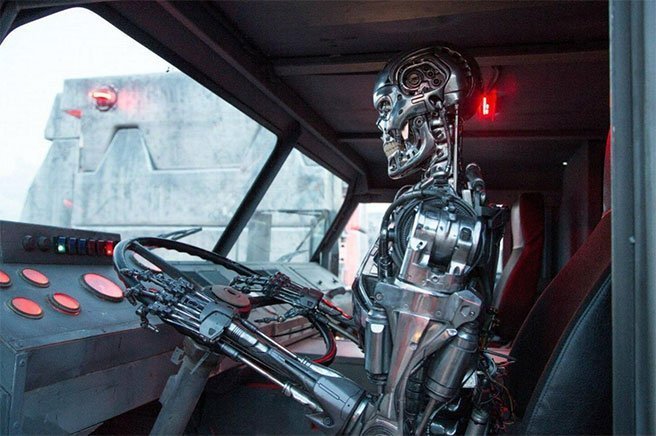Robotrucks versus short-sea shipping

Roar Adland, shipping chair professor at Norwegian School of Economics, pours some cold water on the week’s big news of a first autonomous boxship.
Will autonomous vessels save short-sea shipping, much like good ol’ Arnold, or will a fleet of nimble cloud-controlled autonomous trucks continue to roll over the industry like Skynet? With the recent presentation of the electrified and (eventually) autonomous container concept ship, the Yara Birkeland, the fight is on.
Outside of the high-volume, short-haul intended trade (33 nautical miles!) for this vessel, the odds for short-sea shipping may not be good. It’s not about technology – the technology for autonomous ships is largely there and any remaining challenges can be solved – engineers always can. It’s mainly about land-based competition and, to a lesser extent, about regulation, certainly at the international level.
Autonomous vessels are being seen as a savior because of lower costs. While even that is highly debatable (see my article Unmanned ships revisited) and remains to be seen in reality, let’s suppose it’s correct that taking out crew can reduce the unit transportation cost in the order of 30%. Let’s even give conventional trucks and conventional vessels the same initial cost base, though the gain in market share of land-based regional freight transport in recent decades suggests otherwise.
It’s easy to forget that other transport modes have had the same bright idea, and with potentially much greater economic benefits. Autonomous trucks, powered by renewable energy, will become available a lot sooner and cheaper than autonomous vessels (e.g. Tesla’s prototype semi truck is due to be unveiled in September 2017). The killer selling point that autonomous trucks have up their sleeve is that productivity will roughly double once the driver is no longer needed. While human drivers are bound by law (and physiology) to rest for about 50% of the time, such limitations do not apply to computers and so the direct result of this is an easy 50% reduction in unit freight transportation costs. This is not even accounting for the roughly 30% savings in operating costs from not employing a driver in the first place. Autonomous ships will not have this gain in productivity, as they tend to operate 24 hours per day already, though of course both modes are subject to constraints in the operating times of ports/depots. In an autonomous and fully electrified world of freight transportation, the numbers still don’t add up for short-sea shipping.
Ironically, regulation, or more specifically, taxation may be the only thing that could tilt the odds in shipping’s favour. Land-based freight transportation currently enjoy an extremely unfair advantage in that governments provide infrastructure (roads) that is nearly free for the user and ultimately pay a large share of its externalities (accidents, the cost of local emissions). At the same time, governments are looking for ways to “tax the robots” in a digitalised world. Without any further negative effect on trucker employment, the taxation of robotrucks could finally allow for governments to internalise these externalities (i.e. make the user pay for the true cost on society). Of course, as with any expectation of reasonable politics, this is a long shot.
With leading shipping nations such as Norway, Finland and Singapore gearing up to participate in the technological race towards autonomous shipping, this is an extremely important discussion to have – before we spend billions on nice gadgets.

Interesting indeed. IT depends on how we look at things and for how long in the future and who pay us for having our views. What we tend to forget is the fact that Finland, Norway and Singapore is certainly spending money but they are connecting with the biggest digital players on this planet at the same time! We still over estimate short term and underestimate long term effects. Put this in a 20 year time frame and what all the collaborators digital and OEM have achieved and learnt together and what will be the outcome from that? We cannot stop this train and in a digital world no one will be safe because innovation speed will pick up for sure. What we see now is just the tip of the R&D iceberg and if we think this is high science we need to think again. A lot of amazing innovation will hit our face in the next 10 years for sure ??